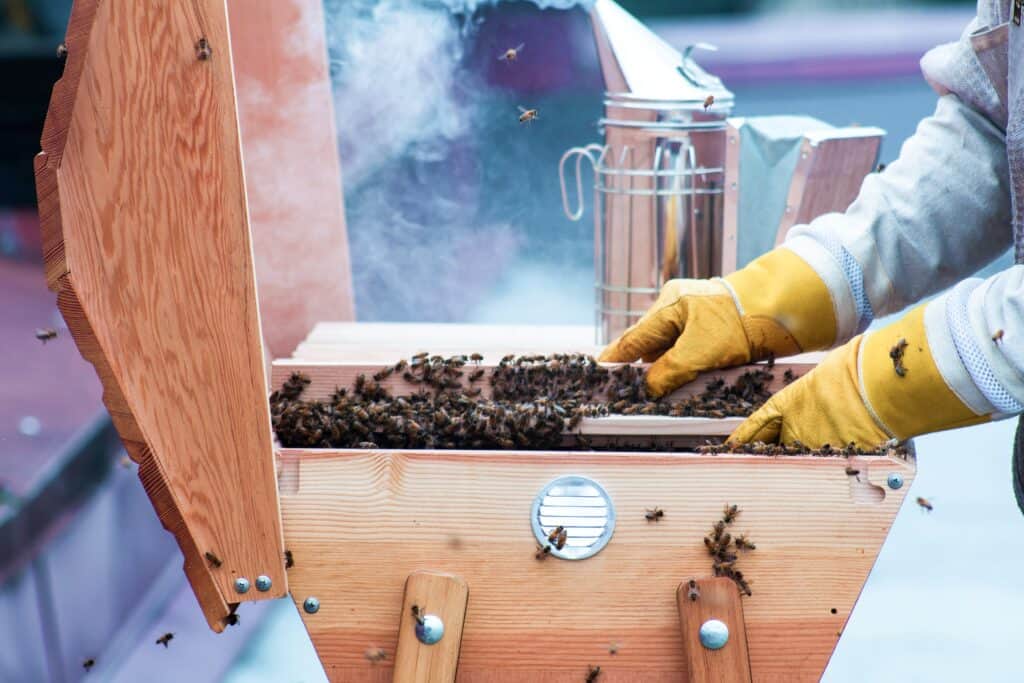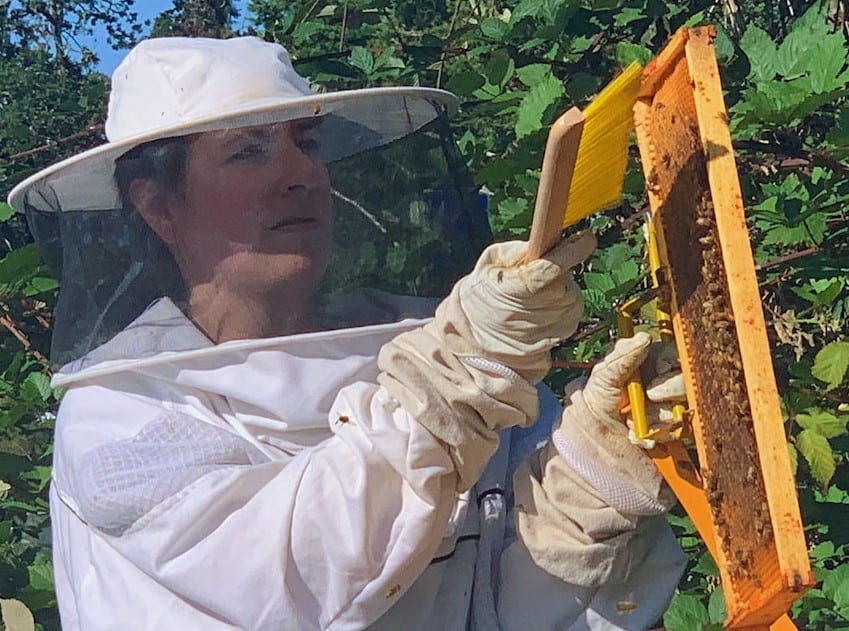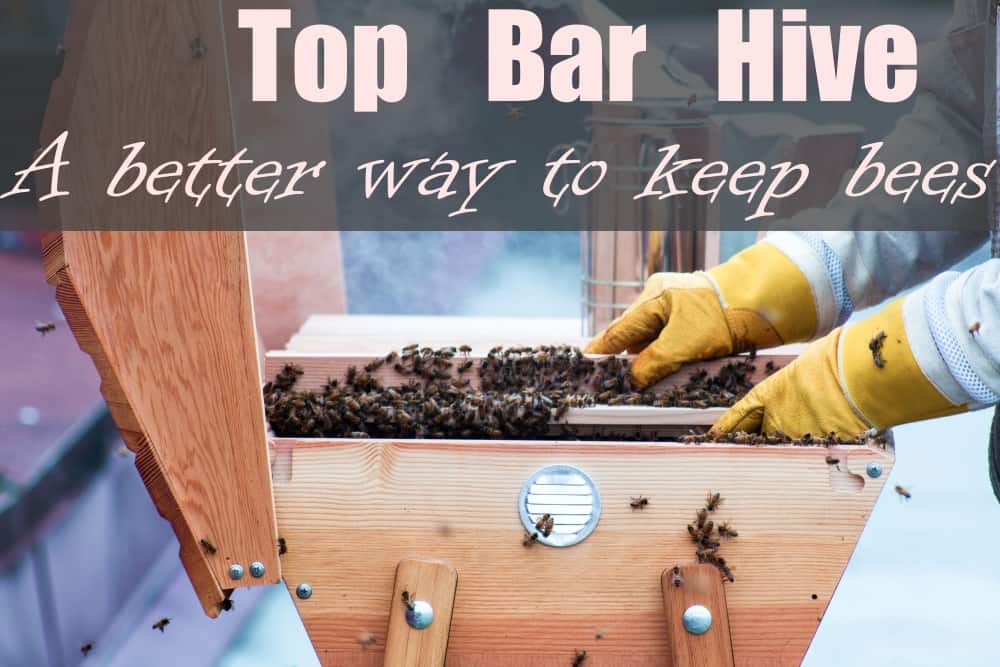In beekeeping, a hive is a currency. It allows us to trade with bees. They get a cozy living space. We get their surplus products and pollination services. Win-win.
Bees, being industrious, can live in any kind of hive. Choosing bee hives is about picking a design that is the most convenient for you. Top bar hives are affordable and easy to use.
What is a Top Bar Hive?
A top bar hive, also known as a Kenyan top bar hive (KTBH), is a horizontal hive. Hence, it is also sometimes referred to as the horizontal top bar hive.
These horizontal hives are somewhere between a log hive and a Langstroth beehive. It gets its name from the wood strips, known as bars, where the bees build their comb.
The bars within the hive body contain a guide to show the bees where the beekeeper would like them to draw a comb. They can be rectangular or trapezoidal and hold between 15 and 20 bars.
These top bar hives are popular with hobbyists.

Advantages of a top bar hive
- No heavy lifting required – With no supers, hive management will not break your back. Great for both young and old, and user-friendly for the physically challenged beekeeper.
- Bees are calmer during hive inspection – The top bars form a barrier between you and the nest. The bees have no reason to fly at you once you open the top of the hive. Every bar you remove reveals a small opening, allowing you to do your inspection with minor interruption to the bees.
- Allows for a more natural beekeeping method – Without foundation, the bees tend to construct the comb they want when they want it. You can learn a lot by observing the behavior of the bees in a top bar hive.
- Easy to construct – Whereas a Langstroth hive will cost you more than 100 dollars, making your top bar hive will cost half that, even less when using plain wood or even reclaimed ones. And since the only standard required is adherence to bee space, you customize the design to suit your preference.
Disadvantages of a top bar hive
- Lower honey yield compared to using a Langstroth hive, where you get more honey.
- Cumbersome to move and thus harder to transport.
This type of hive is not the best for commercial honey production, but that doesn’t mean you won’t get a harvest. Next, we’ll tackle how to harvest honey from your hive.
How do I Harvest Honey from Top Bar Hives?
All you need is a bucket or a large container with a lid, a knife, and your hive tool.
Time needed: 45 minutes
Open the hive.
Whether your top bar hive has a removable or hinged roof, gently open the hive by lifting the top cover.
Remove the bar farthest from the brood comb.
One by one, lift and remove the bars in the entire hive, starting from the end farthest from the brood comb. Use a hive tool to gently pry the bars loose if they are stuck.
Check for honey
Use the space to slide the next bar toward the end and lift to confirm if the honeycomb contains any honey. The comb should not have any brood. At least three-quarters of the honey should be capped. If not, return the bar to its position and try the next bar.
Brush the bees off
Lightly brush off the bees that are on the comb. Keep the bee brush vertical to keep it from breaking off. If you have to tilt it to the side, hold it as shown below. Brush the bees into the hive. A full comb of honey is very heavy. Try and get someone to help you if possible.

Cut the comb off the bar.
Carefully cut the comb off the bar into the bucket. You can make one clean cut along the length of the bar. If the bar is very long, you may need to cut the entire comb off in bits. Seal the bucket to keep the bees out.
Replace and close.
Replace the bars in the hive and close the hive.
When Should I Harvest from a Top Bar Hive?
Harvesting from a top bar is done at the same time as Langstroth hives or any other hive type.
How much honey the bees make depends on the availability of nectar and the colony’s health and size going into the nectar flow. Just remember to leave enough honey to get them through the winter or a nectar dearth.
Harvest months will vary depending on your location. Visit your local beekeepers’ association to learn about the nectar flow in your area.
What happens if the bees don’t have enough honey for themselves?
Then, it’s time to feed your bees, which we will discuss next.

How do you Feed a Top Bar Hive?
When choosing a feeder for your top bar hives, you have to keep a few things in mind:
- The bees have no access to the area above the top bars unless you create access
- The time of year will determine the kind of feed needed.
- The feeder needs to fit inside the hive to minimize robbing
With that in mind, you can use existing feeder solutions or make your own.
Baggies
These are very popular because they are cheap and easy to use. All you need is your syrup, a ziplock bag, and a sharp knife or box cutter.
Pour the syrup into the ziplock bag to two-thirds of its capacity. Place it flat on the floor of the hive. Using your box cutters or knife, cut 3 or 4 slits in the bag. Don’t cut near the seams of the bag because it could easily rip open.
The slits allow the bees to access the syrup without the threat of drowning. Keep it about 3 or 4 inches (depending on the size of the bag). With the bag in place, close the hive.
Inverted Jars
Jars are great for feeding. They are reusable, making them environmentally friendly, and they are easy to use. You can either buy a feeder or build one.
Candy boards and sugar bricks
If the bees don’t have enough honey, you will need to feed them. Depending on where you’re located, the weather could get too cold during the winter months for them to drink syrup. They’ll need a solid supplement.
You can make a candy board in the shape of the comb and insert it as close to the cluster as possible. Sugar bricks are another way to go. They are inserted into a wire cage attached to a top bar.
Honey
The best feeding option is the most natural option, honey. Many beekeepers who use top bar hives prefer to use the bees as a source of brood or nurse bees rather than a source of honey.
They prefer not to harvest honey in the fall. That way, the bees have enough to get them through the winter.
How do I Build a Top Bar Hive?
Building a top bar hive is a subjective process. The only standardized part of the hive is the width of the bar. Everything else is up to you. Here’s an example.
Before you grab that saw, here are a few things you need to consider when building your hive:
- Type of wood – Pine is very popular and affordable. If you can spend a little more on the lumber, you can choose cedar, which is even more durable than pine.
- Ventilation and insulation – Gabled covers are popular for this reason. In the summer, they provide an extra available space for the warm air to rise, and you can add some ventilation holes to the covers. In the winter, you can add insulating material that also serves to absorb moisture in the hive.
With lots of plans to choose from, you’re free to find what works best for your situation.
Top Bar Beekeeping Resources
Beekeeping is a life-long journey of learning. No single blog post or book will ever be enough. To get you started on your top bar beekeeping journey, we recommend the following books.
Best for overall newbies in beekeeping
This is a well-written book that covers the basics of beekeeping in general and how to get started with a Top Bar hive. It has gotten great reviews from novices and experts alike.
Best for overall bee health and natural beekeeping
Many beekeepers who turn to top bars are looking for a more natural solution to keeping bees. Sometimes, it doesn’t seem possible, but many beekeepers are doing it. If keeping healthy bees is your goal, this is the book for you.
Best for construction of top bar beehive
Are you considering building a top bar hive? Here’s a manual you can follow when choosing a design.
Best for Advanced beekeepers
Phillip Chandler, the same author who wrote the guide on building the top bar hive, produces this comprehensive book on top bar hive management. It’s great for new beekeepers as well as those who are experienced but new to the world of Top Bar Hives.
Final Thoughts
Top bar beekeeping is centered on the health and well-being of the colony. The byproducts, such as honey and wax, are a secondary priority.
That said, it can still be profitable. Some use top-bar hives for pollination services. Others use it to produce package bees for sale.
Top Bar hives are easy on the pocket and comfortable for the bees. Try one and be part of the discussion.





